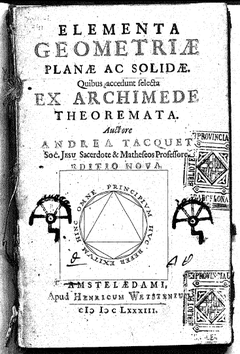André Tacquet

André Tacquet (23 June 1612 Antwerp – 22 December 1660 Antwerp, also referred to by his Latinized name Andrea Tacquet[1]) was a brabantian mathematician and Jesuit Priest. His work prepared ground for the eventual discovery of the calculus.
| Society of Jesus | |
History of the Jesuits | |
He was born in Antwerp, and entered the Jesuit Order in 1629. From 1631 to 1635, he studied mathematics, physics and logic at Leuven. Two of his teachers were Saint-Vincent and Francois d'Aguilon.
Tacquet became a brilliant mathematician of international fame and his works were often reprinted and translated (into Italian and English). He helped articulate some of the preliminary concepts necessary for Isaac Newton and Gottfried Leibniz to recognize the inverse nature of the quadrature and the tangent. He was one of the precursors of the infinitesimal calculus, developed by John Wallis. His most famous work, which influenced the thinking of Blaise Pascal and his contemporaries, is Cylindricorum et annularium (1651). In this book Tacquet presented how a moving point could generate a curve and the theories of area and volume.
He died in Antwerp.
See also
- List of Jesuit scientists
- List of Roman Catholic scientist-clerics
Bibliography
- Opera Omnia Cylindricorum et Annularium (Antwerp, 1651)
- Elementa Geometriae (Antwerp, 1654)
- Arithmeticae Theoria et Praxis (Louvain 1656)
- Cylindricorum et annularium liber V, (Antwerp 1659) full text
Amsterdam,
- Elementa Euclideae, geometriae (Amsterdam 1725) full text
References
|
